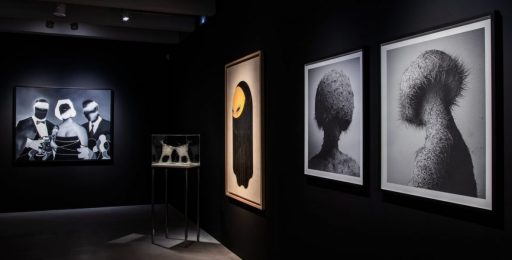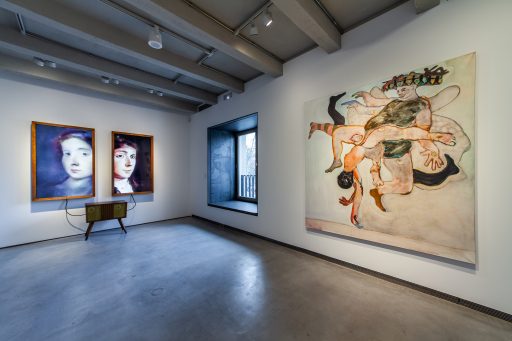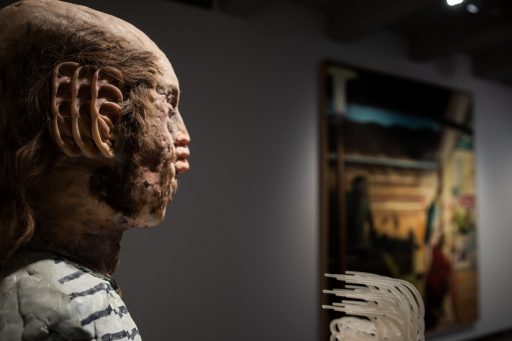Colección SOLO has extended Still Human until 20th December 2021.
David Altmejd, Mario Klingemann, Tomoo Gokita, Neo Rauch, Nina Saunders, Nam June Paik, Evru/Zush and Miriam Cahn feature in this dialogue on how we create, observe and interact with new developments.

With Still Human, Colección SOLO looks to observe our relationship with newness from a range of different artistic perspectives. It focusses the debate on human potential for development in the face of social or technological change. Works such as those by Nina Saunders or Mario Klingemann illustrate how novel aesthetic and conceptual fields are being opened up, supporting the exhibition’s premise that developments become springboards for extending the limits of collective knowledge, so enabling new ideas to emerge.
Within this context, Still Human includes work whose primary creative tool is artificial intelligence.
In Memories of Passersby I, a machine created by Mario Klingemann and trained on European grand master paintings generates a constant stream of portraits, while Appropriate Response produces phrases in real time using artificial intelligence.
Saunders, meanwhile, takes the opportunity to make us “think again.” With pieces such as Greta, the Danish artist invites us not only to rethink specific objects but reflect on our surroundings. Her works connect with others present in Still Human, such as the repurposed everyday objects by US artist Willie Cole, who defines himself as a “perceptual engineer.”

The ongoing relationship between artistic creativity and technological advancement has enabled new routes to emerge in the visual arts. These are illustrated in Still Human through works by video art pioneer Nam June Paik or the AI-art of Mario Klingemann and Egor Kraft, among others. Nam June Paik, present in the exhibition with Antenna Buddha, not only extended the limits of artistic expression but also highlighted one of the most inherent features of being human: our ability to play. Homo ludens appears in the exhibition through works such as Brick and Fingers by Nik Ramage, sculpture by Tony Matelli and the art of Juan Díaz-Faes, who plays around not only with materials such as ceramic but also algorithmic research.
Newness and plasticity
Nam June Paik’s playful approach is reflected in the work of Cassie McQuater too. This young artist harnesses video game narratives as a feminist means of expression and therapeutic space to alleviate her insomnia. In Still Human, McQuater is presented alongside Spanish artist Evru/Zush, exploring artists’ response to change as an exercise in neuroplasticity. Evru/Zush, who has worked extensively on the therapeutic benefits of creativity, is an example of constant change in terms of his artistic media, output and identity.

New creative routes made possible by technological developments — such as the invention of tin paint tubes and emergence of Impressionism — are reflected in Still Human with pieces such as Half Human – Half Machine Portraits Series by Sholim or the 4D video animation of Nikita Diakur, unthinkable before the development of digital imagery. Cool 3D World and SMACK venture into the “uncanny valley,” the concept put forward by Masahiro Mori to define the unease produced by robots or animations which seem too human.
Fluidity and critique
Work by these emerging digital artists is presented in Still Human alongside pieces which tackle new realities through more classical materials. These include sculptures by David Altmejd or the hybrid characters of Neo Rauch.

Liquid borders between the concepts of what we are and what we might be are also to be found in Im Fernsehen gesehen by Miriam Cahn or the modified organic-digital figures of Can Pekdemir. Using digital collage, Yang Yongliang transforms the ancient Chinese art of landscape painting into critical discourse on extreme urbanisation.
The apocalyptic yet fascinated vision of the future developed in 1950s comics is also present in Still Human through the retro-futuristic artworks of Ryan Heshka and Sergio Mora, two artists who have benefitted from Colección SOLO’s artist support programmes.
Sound objects
The musician Lars Dietrich explores the possibilities of transforming jazz performance by developing and playing with sound robots; the evolution of this work into a stand-alone piece is Lily: A Modernised Music Box. Another exercise in sound-based creativity is the delicate beat machine created by artist and composer Koka Nikoladze, on display until July as part of Still Human, an exhibition which will also feature a programme of activities running in parallel over the coming months.
Book your visit here
More about Still Human here.

